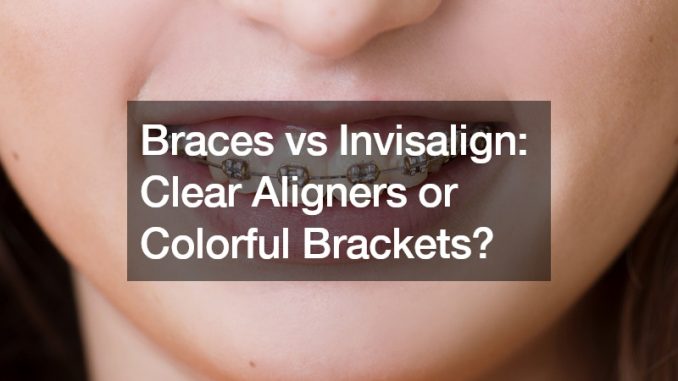

A straight smile can boost confidence and improve overall oral health. But for many people considering orthodontic treatment, the question remains: braces or Invisalign? Both methods effectively straighten teeth, but they differ in visibility, maintenance, and responsibility. Understanding these differences can help you choose the treatment that best suits your lifestyle and preferences.
Traditional Braces: Effective and Customizable
Traditional braces, consisting of metal brackets, wires, and rubber bands, are a time-tested method for straightening teeth. Their effectiveness is undeniable, and dentists have honed their skills in using them for decades. Braces work relatively quickly, often achieving results in less time than Invisalign.
They also offer some level of customization, with colored bands adding a touch of personal flair, especially popular among children and teenagers.
However, braces come with some drawbacks. Maintaining proper oral hygiene can be challenging due to the brackets and wires creating nooks and crannies where food particles can lodge. This necessitates more diligent brushing and flossing to avoid plaque buildup and potential cavities. Additionally, certain foods like hard candy or sticky treats are off-limits to prevent damaging the brackets or wires. Finally, the metal structure of traditional braces is quite noticeable, a factor that may deter some self-conscious individuals.
Invisalign: Discreet and Removable
Invisalign offers a clear alternative to traditional braces. The system utilizes a series of clear, removable plastic aligners that gradually shift teeth into the desired position. Unlike braces, Invisalign is virtually invisible, making it a popular choice for adults and teenagers who may be concerned about the aesthetics of metal braces. The removable nature of the aligners allows for greater flexibility with eating and brushing. You can simply take them out to enjoy your favorite foods and clean your teeth thoroughly.
However, invisibility comes with a price tag – responsibility. Invisalign aligners require consistent wear, typically for 22 hours a day. Failing to wear them for the recommended time can significantly slow down treatment progress. Additionally, the aligners themselves can stain if you don’t remove them while consuming certain beverages like coffee or tea. Regular cleaning of the aligners is also crucial to maintain hygiene.
Choosing the Right Treatment
Ultimately, the best choice between braces and Invisalign depends on your individual needs and preferences. Here are some factors to consider:
- Visibility: If you prioritize a discreet treatment option, Invisalign’s clear aligners may be the better choice.
- Maintenance: Braces require more meticulous oral hygiene due to the fixed brackets and wires. If you’re confident in your ability to brush and floss diligently, braces are a viable option.
- Discipline: Invisalign’s success hinges on consistent wear. If you struggle with sticking to routines, braces might be a better fit due to their fixed nature.
- Lifestyle: Consider your dietary habits and social activities. If you enjoy certain foods that are difficult to eat with braces, or participate in sports where contact could damage braces, Invisalign might be preferable.
Consulting Your Dentist
A consultation with your dentist is crucial before making a decision. They can assess your individual needs, oral health, and lifestyle to determine which treatment option is most suitable. They can also discuss treatment timelines, costs, and any potential challenges associated with either braces or Invisalign.
Both braces and Invisalign offer effective paths to a straighter smile. By understanding the advantages and disadvantages of each method, and consulting with your dentist, you can confidently choose the treatment that best aligns with your goals and lifestyle. A bright, confident smile awaits!
.
